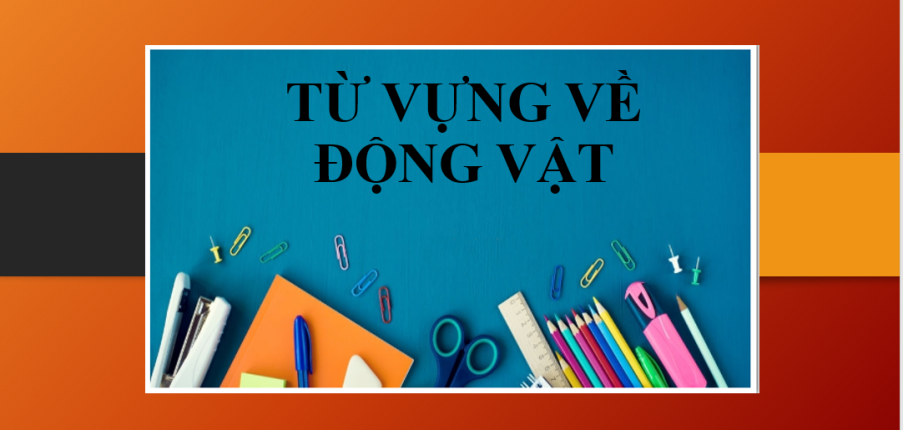Từ vựng IELTS chủ đề: Animals | Từ vựng tiếng Anh về con vật
Từ vựng tiếng Anh về con vật
1. Từ vựng tiếng Anh về con vật nuôi
Từ vựng tiếng Anh về con vật nuôi – chủ đề đầu tiên bạn nên thuộc lòng trước khi học từ vựng IELTS chủ đề Animals:
| Từ vựng tiếng Anh về con vật |
Ý nghĩa |
Ví dụ |
| Dog (dɒg) |
Con chó |
I named that dog Mickey (Tôi đặt tên con chó đó là Mickey).
|
| Cat (kæt) |
Con mèo |
My sister’s black cat is basking in the sun on the porch (Con mèo đen của chị tôi đang phơi nắng ở hiên nhà). |
| Chick |
Con gà con |
The chick just hatched yesterday (Chú gà con mới nở ngày hôm qua). |
| Goldfish (’ɡoʊld,fɪʃ) |
Cá vàng |
People often release goldfish on Kitchen guardians (Mọi người thường thả cá vàng vào ngày ông Công ông Táo). |
| Parrot (pærət) |
Con vẹt |
That parrot keeps parodying me (Con vẹt kia cứ nhại lại tôi). |
| Duck (dək) |
Vịt |
A duck spread out two wings (Một con vịt xòe ra hai cái cánh). |
| Dove (dəv) |
Bồ câu |
The dove is a symbol of peace (Chim bồ câu là biểu tượng của hòa bình). |
| Piglet |
Lợn con |
That piglet has a very pretty pink color (Chú heo con đó có màu hồng rất xinh). |
| Calf (kɑːf) |
Con bê |
The calf is the child of the cow (Con bê là con của con bò). |
| Cow (kaʊ) |
Con bò cái |
The calf is the child of the cow (Con bê là con của con bò). |
| Bull (bʊl) |
Con bò đực |
Bulls are grazed with cows on public grazing grounds (Bò đực được chăn thả với bò cái trên bãi chăn thả công cộng). |
| White mouse (waɪt maʊs) |
Con chuột bạch |
I wish I could have a white mouse (Tôi ước tôi có thể có một con chuột bạch). |
| Camel |
Con lạc đà |
Camels eat grass, leaves and branches from any plant in the desert (Lạc đà ăn cỏ, lá và cành từ bất kỳ loài thực vật nào trên sa mạc). |
| Turkey (ˈtɜːki) |
Gà tây (Con gà trong ngày Giáng sinh) |
My uncle in the UK usually eats turkey on Christmas Eve (Chú tôi ở Anh thường ăn gà tây vào đêm Giáng sinh). |
2. Từ vựng tiếng Anh về động vật hoang dã
| Từ vựng tiếng Anh về con vật |
Ý nghĩa |
Ví dụ |
| Hippopotamus (ˌhɪpəˈpɒtəməs) |
Con hà mã |
The hippopotamus is a large herbivorous mammal that lives in sub-Saharan Africa (Hà mã là một loài động vật có vú ăn cỏ lớn sống ở châu Phi cận Sahara). |
| Chipmunk /ˈʧɪpmʌŋk/ |
Sóc chuột |
The chipmunk is a very cute species with exceptionally large eyes, bushy tail and chubby cheeks (Sóc chuột là một loài rất dễ thương với đôi mắt to đặc biệt, chiếc đuôi rậm rạp và đôi má phúng phính). |
| Coyote – /’kɔiout/ |
Chó sói |
Movies about wolf talent always attract fans (Những bộ phim về tài năng của loài sói luôn thu hút người hâm mộ). |
| Hare |
Thỏ rừng |
Yesterday me and my uncle went hare hunting (Hôm qua tôi và chú tôi đã đi săn thỏ rừng). |
| Puma – /pjumə/ |
Con báo |
The puma is one of the best predators on the African savanna (Con báo là một trong những loài săn mồi giỏi nhất trên xavan châu Phi). |
| Mink /mɪŋk/ |
Con chồn |
The mink constantly raises its head and makes a sound that teases the dog (Chú chồn liên tục ngóc đầu dậy và phát ra âm thanh trêu chọc chú chó). |
| Mammoth /mæməθ/ |
Voi ma mút |
The mammoth is an extinct species of ancient elephant (Voi ma mút là một loài voi cổ đại đã tuyệt chủng). |
| Alligator (ˈælɪgeɪtə) |
Con cá sấu |
Crocodile ashore is a folk game from Vietnam (Cá sấu lên bờ là một trò chơi dân gian của Việt Nam). |
| Hedgehog (ˈhɛʤhɒg) |
Con nhím |
Hedgehog is a large animal, belonging to the order of rodents (Nhím là một loài động vật lớn, thuộc bộ gặm nhấm). |
| Kangaroo (ˌkæŋgəˈru) |
Con chuột túi |
The biggest feature of kangaroos is the ability to walk and jump on two legs like humans (Đặc điểm lớn nhất của chuột túi là khả năng đi và nhảy bằng hai chân như con người). |
| Squirrel (ˈskwɪrəl) |
Con sóc |
Squirrels are small animals, small in size, only about 7 to 10 cm, weighing about 10 grams (Sóc là loài động vật nhỏ, có kích thước nhỏ, chỉ khoảng 7 đến 10 cm, nặng khoảng 10 gam). |
| Donkey |
Con lừa |
The donkey’s child is a mule (Con của con lừa là con la). |
| Rhinoceros (raɪˈnɒsərəs) |
Con tê giác |
There are 6 unusually dead rhinos in Nghe An ecological area (Có 6 con tê giác chết bất thường ở khu sinh thái Nghệ An). |
3. Từ vựng tiếng Anh về các loại thú
| Từ vựng tiếng Anh về con vật |
Ý nghĩa |
Ví dụ |
| Porcupine (ˈpɔːkjʊpaɪn) |
Con nhím |
In the fable, the fox uses a variety of cunning strategies to capture the porcupine (Trong truyện ngụ ngôn, con cáo sử dụng nhiều chiến thuật xảo quyệt khác nhau để bắt nhím). |
| Polar bear (ˈpəʊlə beə) |
Con gấu Bắc cực |
As sea ice disappears, the viability of polar bear populations also decreases (Khi băng biển biến mất, khả năng tồn tại của quần thể gấu Bắc Cực cũng giảm). |
| Buffalo (ˈbʌfələʊ) |
Con trâu nước |
Water buffalo has gray, short and hard coat (Trâu nước có bộ lông xám, ngắn và cứng). |
| Beaver (ˈbiːvə) |
Con hải ly |
Beavers build dams for nesting (Hải ly xây đập để làm tổ). |
| Koala bear (kəʊˈɑːlə beə) |
Gấu túi |
The koala is the world’s most “stupid” animal (Gấu túi là loài động vật “ngu ngốc” nhất thế giới). |
| Boar (bɔː) |
Con lợn hoang |
Crocodiles eat anything that’s easy to catch and wild boar is the perfect-sized prey (Cá sấu ăn bất cứ thứ gì dễ bắt và lợn hoang là con mồi có kích thước hoàn hảo). |
4. Từ vựng tiếng Anh về các loại côn trùng
| Từ vựng tiếng Anh về con vật |
Ý nghĩa |
Ví dụ |
| Ladybug (ˈleɪdɪbʌg) |
Con bọ rùa |
Ladybugs are insects belonging to the order beetles (Bọ rùa là côn trùng thuộc bộ bọ cánh cứng). |
| Mosquito (/mɒˈskiːtəʊ/) |
Con muỗi |
The female mosquito after sucking blood can lay 50-150 eggs (Muỗi cái sau khi hút máu có thể đẻ 50-150 trứng). |
| Tarantula (ˈræntjʊlə) |
Loại nhện lớn |
Tarantulas are slow and deliberate movers, but accomplished nocturnal predators (Loài nhện lớn là những kẻ di chuyển chậm chạp và có chủ ý, nhưng lại là những kẻ săn mồi về đêm thành công).
|
| Praying mantis (ˈpreɪɪŋ ˈmæntɪs) |
Bọ ngựa |
The praying mantis is sweet, salty, slightly fishy, and non-toxic (Bọ ngựa có vị ngọt, mặn, hơi tanh, không độc). |
| Caterpillar (ˈkætəpɪlə) |
Sâu bướm |
When caterpillars mature, humans usually catch them by hand (Khi sâu bướm trưởng thành, con người thường bắt chúng bằng tay). |
| Parasites (ˈpærəsaɪts) |
Ký sinh trùng |
Pinworms are the most common parasites (Giun kim là loại ký sinh trùng phổ biến nhất). |
| Honeycomb (ˈhʌnɪkəʊm) |
Tổ ong |
Honeycomb is where bees live (Tổ ong là nơi ong sống). |
| Cockroach (ˈkɒkrəʊʧ) |
Con gián |
100 cockroaches will be released to conduct research (100 con gián sẽ được thả để tiến hành nghiên cứu). |
| Grasshopper (ˈgrɑːsˌhɒpə) |
Con châu chấu |
Grasshoppers are a great source of protein (Châu chấu là một nguồn cung cấp protein tuyệt vời). |
5. Từ vựng tiếng Anh về các loại lưỡng cư
| Từ vựng tiếng Anh về con vật |
Ý nghĩa |
Ví dụ |
| Frog (frɒg) |
Con ếch |
Frog leg meat contains abundant nutrients (Thịt đùi ếch chứa nhiều chất dinh dưỡng). |
| Snail – (sneil) |
Ốc sên |
Snails are mollusks and omnivores (Ốc sên là động vật thân mềm và ăn tạp). |
| Dragon (ˈdrægən) |
Con rồng |
Dragon with the most terrible power in legend (Rồng có sức mạnh khủng khiếp nhất trong truyền thuyết). |
| Turtle (tɜːtl) |
Con rùa |
The turtle symbolizes longevity (Con rùa tượng trưng cho sự trường thọ). |
| Cobra (ˈkəʊbrə) |
Con rắn hổ mang |
Cobras have a very large weight and are longer than other venomous snakes (Rắn hổ mang có trọng lượng rất lớn và dài hơn các loài rắn độc khác). |
| Toad (təʊd) |
Con cóc |
The toad is an amphibian (Con cóc là động vật lưỡng cư). |
| Dinosaurs (ˈdaɪnəʊsɔːz) |
Con khủng long |
Apatosaurus is a genus of herbivorous dinosaur (Apatosaurus là một chi khủng long ăn cỏ). |
| Chameleon (kəˈmiːliən) |
Con tắc kè hoa |
Chameleons have the ability to roll their eyes 360 degrees (Tắc kè hoa có khả năng đảo mắt 360 độ). |
| Lizard (ˈlɪzəd) |
Con thằn lằn |
Raising ornamental lizards is actually not as difficult as people often imagine (Nuôi thằn lằn cảnh thực ra không khó như mọi người vẫn thường tưởng tượng). |
6. Từ vựng tiếng Anh về động vật dưới nước
| Từ vựng tiếng Anh về con vật |
Ý nghĩa |
Ví dụ |
| Scallop /skɑləp/ |
Sò điệp |
Grilled scallops with onion fat is one of the delicious seafood dishes (Sò điệp nướng mỡ hành là một trong những món hải sản ngon). |
| Eel /il/ |
Lươn |
The delicious taste of Nghe eel soup will make you ecstatic (Hương vị thơm ngon của món súp lươn xứ Nghệ sẽ khiến bạn ngất ngây). |
| Carp /kɑrp/ |
Cá chép |
Carp is a freshwater fish (Cá chép là loài cá nước ngọt). |
| Octopus (ˈɒktəpəs) |
Bạch tuộc |
Octopus eats its own body after mating (Bạch tuộc ăn thịt chính cơ thể mình sau khi giao phối). |
| Seahorse (kræb) |
Con cá ngựa |
Seahorse is a truly unique creature of the ocean world (Cá ngựa là một sinh vật thực sự độc đáo của thế giới đại dương). |
| Crab (kræb) |
Con cua |
The crab has 8 legs and 2 claws (Con cua có 8 chân và 2 càng). |
| Starfish (ˈstɑːfɪʃ) |
Con sao biển |
Starfish are invertebrates (Sao biển là động vật không xương sống). |
| Jellyfish (ˈʤɛlɪfɪʃ) |
Con sứa |
Jellyfish have no brain and heart (Sứa không có não và tim). |
| Squid (skwɪd) |
Con mực |
Squid has a delicious, supple meat layer (Mực có lớp thịt thơm ngon, dẻo dai). |
7. Từ vựng tiếng Anh về các loài chim
| Từ vựng tiếng Anh về con vật |
Ý nghĩa |
Ví dụ |
| Owl /aʊl/ |
Cú mèo |
Owls are usually brown, gray, and have lighter hair on the belly and face (Cú thường có màu nâu, xám, màu nhạt hơn ở bụng và mặt). |
| Ostrich /ˈɒstrɪʧ/ |
Đà điểu |
The ostrich is also known as the running bird (Đà điểu còn được gọi là chim chạy). |
| Falcon /ˈfɔːlkən/ |
Chim ưng |
Falcon owns a speed of 390 km/h (Falcon sở hữu tốc độ 390 km/ h). |
| Swan /swɒn/ |
Thiên nga |
The eleven princes turned into eleven swans and flew towards the murky forest along the coast (Mười một hoàng tử biến thành mười một con thiên nga và bay về phía khu rừng âm u ven biển). |
| Heron /ˈhɛrən/ |
Diệc |
The Norwegian cities of Forsand and Tysvær have herons in their coat of arms (Các thành phố Forsand và Tysvær của Na Uy có huy hiệu diệc). |
| Sparrow /ˈspærəʊ/ |
Chim sẻ |
In the mythology of the Greek nations, the sparrow is a bird symbolizes intense love (Trong thần thoại của các quốc gia Hy Lạp, chim sẻ là loài chim tượng trưng cho tình yêu mãnh liệt). |
| Peacock /ˈpiːkɒk/ |
Con công (trống) |
Peacock feathers can absorb energy from heaven and earth (Lông công có thể hấp thụ năng lượng từ đất trời). |
| Woodpecker /ˈwʊdˌpɛkə/ |
Chim gõ kiến |
Woodpeckers store food by shoving acorns into holes in the tree and must be constantly on guard to prevent theft (Chim gõ kiến dự trữ thức ăn bằng cách nhét quả sồi vào các lỗ trên cây và phải thường xuyên canh gác để đề phòng trộm cắp). |
| Eagle /ˈiːgl/ |
Chim đại bàng |
Eagle is a carnivorous bird (Đại bàng là loài chim ăn thịt). |
Một số từ vựng IELTS chủ đề Animals
| Từ vựng IELTS chủ đề Animals & Ý nghĩa |
Ví dụ |
Hình ảnh |
| Captive breeding/ Captive propagantion: nhân giống trong điều kiện nuôi nhốt. |
Captive breeding techniques began with the first human domestication of animals at least 10,000 years ago.
Kỹ thuật nhân giống trong điều kiện nuôi nhốt bắt đầu từ việc con người thuần hóa động vật đầu tiên ít nhất 10.000 năm trước.
|
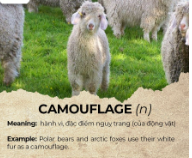 |
| Camouflage (n): hành vi, đặc điểm nguỵ trang (của động vật) |
Polar bears and arctic foxes use their white fur as camouflage.
Gấu Bắc Cực và cáo Bắc Cực sử dụng bộ lông trắng của chúng để ngụy trang.
|
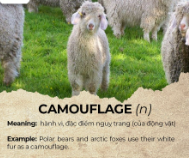 |
| Domestication (n): sự thuần hoá động, thực vật |
Domestication traits were selected during the initial episode of domestication of animals.
Các đặc điểm thuần hóa được lựa chọn trong giai đoạn thuần hóa động vật ban đầu.
|
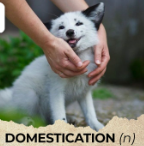 |
| Guinea pig (n): chuột bạch, người hoặc con vật dùng làm thí nghiệm (nghĩa bóng) |
Some people have been asked to be guinea pigs in research into seasonal influenza.
Một số người đã được yêu cầu trở thành chuột bạch trong một cuộc nghiên cứu về bệnh cúm theo mùa.
|
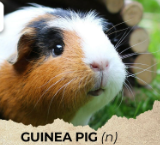 |
| Anthropomorphism (n): sự nhân hoá |
Anthropomorphism is a well-established literary device from ancient times, employed to illustrate principles of life or personality stereotypes.
Nhân hóa là một công cụ văn học đã có từ thời cổ đại, được sử dụng để minh họa các nguyên tắc sống hoặc khuôn mẫu tính cách.
|
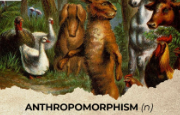 |
| Natural selection (n): chọn lọc tự nhiên |
Natural selection selects very different-looking animals to fill the different niches of the ecosystem.
Chọn lọc tự nhiên chọn những động vật có vẻ ngoài rất khác nhau để lấp đầy các ngóc ngách khác nhau của hệ sinh thái.
|
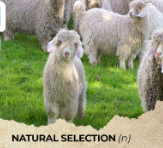 |
| Bushmeat (n): thịt thú rừng bị săn bắn |
Commercial harvesting and trading of bushmeat were considered a threat to biodiversity.
Khai thác và buôn bán thịt bụi vì mục đích thương mại được coi là mối đe dọa đối với đa dạng sinh học.
|
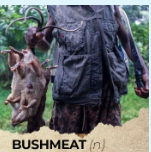 |
| Poaching (n): hành vi săn bắn động vật hoang dã bất hợp pháp |
The government needs to take action to deal with poaching and trafficking of protected animals.
Chính phủ cần hành động để đối phó với nạn săn trộm và buôn bán động vật được bảo vệ.
|
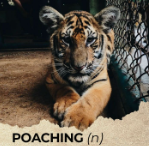 |
| Food chain (n): chuỗi thức ăn |
Humans aren’t at the top of the food chain, but towards the middle, at a level similar to pigs and anchovies.
Con người không phải ở đầu chuỗi thức ăn, nhưng ở giữa, ở mức tương tự như lợn và cá cơm.
|
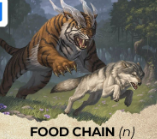 |
Bài mẫu Writing Part 2 có sử dụng từ vựng IELTS chủ đề Animals
1. Đề bài
Nowadays animal experiments are widely used to develop new medicines and to test the safety of other products. Some people argue that these experiments should be banned because it is morally wrong to cause animals to suffer, while others are in favour of them because of their benefits to humanity. Discuss both views and give your opinion.
2. Bài mẫu IELTS Writing Part 2
Conducting experiments on animals is commonplace in the world today. This practice, according to some, is beneficial because it helps develop drugs and general products which are safer for humans to consume. Although these benefits are real, they are far less significant than the sufferings of the animals involved in the tests. It is, thus, imperative that all forms of animal testing be forbidden by law.
Performing tests on animals is advantageous to humans in different ways. From a medical standpoint. this is to guarantee that new drugs are effective and safe before they are tested on human volunteers. Any side effects that are spotted on the animal being tested can be thoroughly examined, so that the risks when taking new pharmaceuticals for humans are significantly mitigated. From the perspective of product manufacturers, this practice serves a similar purpose of safety for consumers. A new type of lipstick or a new recipe for canned porridge, for example, might all be dangerous to humans without first being tested on other species.
It is however recommended that the government should introduce a ban on conducting tests on animals. This is because doing harm to them is morally unacceptable, irrespective of the benefits humans may reap. It is understandable that in the past, employing animals as test objects was the only viable way because there were no alternatives. Now that advanced testing methods such as using artificial biological molecules are available, it is no longer necessary to perform drug and product tests on animals. This means that a strict ban on this form of tests can force pharmaceutical companies and product manufacturers to switch to modern techniques which do not employ any living creatures while still ensuring the safety of the items they produce.
In summary, due to the advent of modern biological technologies such as using engineered cells, new products and medicines can be tested for effectiveness and safety without the need of animals. This means the suffering caused to these living creatures is now much more considerable than the benefits of performing experiments on them.
Bài tập từ vựng IELTS về chủ đề động vật
Bài 1: Nối các từ ở bên trái với nghĩa đúng của chúng ở bên phải
|
1. Extinction
2. Poach
3. Conservation
4. Boycott
5. Habitat
|
a. The condition of being imprisoned or confined.
b. The illegal hunting, capturing, or killing of wildlife or fish.
c. The process of a species, family, or larger group being permanently destroyed or dying out.
d. The natural home or environment of an animal, plant, or other organism.
e. To refuse to buy, use, or participate in something as a way of protesting.
|
Đáp án:
1. Extinction - c. The process of a species, family, or larger group being permanently destroyed or dying out.
2. Poach - b. The illegal hunting, capturing, or killing of wildlife or fish.
3. Conservation - (None of the provided options directly match this definition. It's about preserving, protecting, or restoring the natural environment and wildlife.)
4. Boycott - e. To refuse to buy, use, or participate in something as a way of protesting.
5. Habitat - d. The natural home or environment of an animal, plant, or other organism.
Bài 2: Điền vào chỗ trống với từ đúng trong danh sách
|
in danger of extinction conservation poaching boycott habitat
|
1. Many rare species are now ________ due to deforestation.
2. Environmentalists are working hard to promote the ________ of endangered species.
3. The government has implemented strict penalties to deter the ________ of wild animals.
4. Activists encouraged the public to ________ products made from animal fur.
5. After the wildfire, the ________ of many animals was completely destroyed.
Đáp án:
1. Many rare species are now in danger of extinction due to deforestation.
2. Environmentalists are working hard to promote the conservationof endangered species.
3. The government has implemented strict penalties to deter the poaching of wild animals.
4. Activists encouraged the public to boycott products made from animal fur.
5. After the wildfire, the habitat of many animals was completely destroyed.
Bài 3: Viết lại câu sử dụng từ cho sẵn mà không làm thay đổi nghĩa của chúng
1. The complete disappearance of elephants from this region is a serious concern. (Extinction)
2. Illegally capturing birds for trade is a major problem in this area. (Poach)
3. The action of keeping natural areas untouched to protect wildlife is essential. (Conservation)
4. Consumers are advised to avoid buying goods from companies that harm the environment. (Boycott)
5. The natural living area of these animals is being threatened by urban expansion. (Habitat)
Đáp án:
1. The complete extinction of elephants from this region is a serious concern.
2. Illegally poaching birds for trade is a major problem in this area.
3. The action of conservation of natural areas to protect wildlife is essential.
4. Consumers are advised to boycott goods from companies that harm the environment.
5. The habitat of these animals is being threatened by urban expansion.
Bài 4: Điền vào chỗ trống
1. The ____________ kingdom includes a wide variety of organisms, from microscopic insects to massive mammals.
2. A ____________ is a warm-blooded vertebrate that gives birth to live young and usually has hair or fur.
3. Snakes and turtles are examples of ____________.
4. Frogs and salamanders are classified as ____________ because they can live both in water and on land.
5. Penguins and eagles are examples of ____________.
6. Sharks and goldfish belong to the ____________ category.
7. Butterflies and bees are types of ____________.
8. Many people keep cats and dogs as ____________.
9. Tigers and lions are considered ____________ animals.
10. The process of making a wild animal accustomed to human contact is called
Đáp án:
1. Animal
2. Mammal
3. Reptile
3. Amphibian
4. Bird
5. Fish
6. Insect
7. Pet
8. Wild
10. Domesticated
Bài 5: Điền vào chỗ trống
1. ____________ refers to the variety of plant and animal life in a particular habitat.
2. The study of animals is called ____________.
3. ____________ is a branch of science that focuses on living organisms and their interactions.
4. ____________ efforts are crucial to preserving endangered species.
5. The ____________ of natural resources is essential for maintaining ecological balance.
6. ____________ is the variety of life on Earth.
7. Animals develop ____________ to survive in their environments.
8. Birds often engage in seasonal ____________ for better feeding opportunities.
9. Bears undergo ____________ during the winter months to conserve energy.
10. Chameleons use ____________ to blend in with their surroundings.
11. Owls are known for being ____________, meaning they are active at night.
12. Eagles, on the other hand, are ____________, hunting during the day.
13. Cats that live in the wild are referred to as ____________.
14. Parrots from distant countries are considered ____________ pets.
15. ____________ records provide valuable information about ancient life forms.
16. Fish are adapted to living in ____________ environments.
17. Lions and tigers are examples of ____________ mammals.
18. Dolphins and whales are considered ____________ mammals.
19. ____________ animals live in trees.
20. Snakes and crocodiles are examples of ____________ reptiles.
21. ____________ animals inhabit the ocean.
22. Frogs and salamanders are examples of ____________ amphibians.
23. ____________ animals have a diet consisting mainly of meat.
24. Elephants and giraffes are ____________ animals.
25. Humans and other mammals are ____________, maintaining a constant body temperature.
26. Snakes and lizards are ____________, relying on external heat sources to regulate their temperature.
27. Frogs and fish are examples of ____________ animals.
28. The ____________ of a fish helps it move through the water.
29. Eagles and hawks have sharp ____________ for capturing prey.
30. Horses and cows have ____________ on their feet.
Đáp án:
1. Ecosystem
2. Wildlife
3. Zoology
4. Biology
5. Conservation
6. Protection
7. Biodiversity
8. Adaptation
9. Migration
10. Hibernation
11. Camouflage
12. Nocturnal
13. Diurnal
14. Feral
15. Exotic
16. Fossil
17. Aquatic
18. Terrestrial
19. Avian
20. Marine
21. Arboreal
22. Carnivorous
23. Herbivorous
24. Omnivorous
25. Predator-prey
26. Ectotherm
27. Endotherm
28. Cold-blooded
29. Warm-blooded
30. Scale
31. Feather
Bài 6: Điền vào chỗ trống những từ thích hợp trong khung.
On the one hand, animal experimentation has its own benefits. Firstly, many special.........involved animal testing. Before providing new products or medicines to societies, those products must be tested to.........their safety to humans. Secondly, doing experiments on animals gives researchers knowledge about them and .........Moreover, scientists can .........the negative consequences that animals experience. Thus, this method is.........to save people from suffering risks of some new drugs.
On the other hand, testing on animals is dangerous. The lives of animals should be respected because this can .........the extinction of some species. In some countries, for example, animal testing is now banned. If people keep using them for........., someday there will be no more animals to do so. Besides, there are.........to endorse drugs. With many effective innovations in science and technology, it is.........for scientists to create and invent new methods to test the safety of products. Furthermore, humans have no right to do experiments on animals. For instance, in many cultures, some animals are their.........Using them for any purpose can be contradicting their rules. Therefore, animal experiments can be harmful to wildlife.
Gợi ý:
| endorse |
medical and scientific reasons |
diminish |
possible |
significant |
|
|
main symbols and belief |
their behaviors |
result in |
alternative approaches |
Đáp án:
1. medical discoveries
2. endorse
3. their behaviors
4. diminish
5. significant
6. result in
7. medical and scientific reasons
8. alternative approaches
9. possible
10. main symbols and belief
Bài 7: Chọn từ có thể dùng làm ngôn ngữ diễn đạt cho các từ được gạch chân trong các câu dưới đây.
1. Humans are the most important beings on the planet
A. trivial
B. significant
C. necessary
2. Those animals have a tendency to change their natural behavior negatively and profoundly
A. alter
B. fix
C. exchange
3. Zoos should be retained for the sake of their benefits in protecting wild animals
A. cons
B. hindrances
C. advantages
4. Deforestation has significantly increased
A. risen
B. gone down
C. improved
5. Undomesticated animals
A. wild
B. cruel
C. gentle
Đáp án:
1. B
2. A
3. C
4. A
5. A
Bài 8: Hãy khoanh tròn những câu trả lời đúng.
1. Vivisection/Poaching is an act of carrying out experiments on animals.
2. Instrumental/Sustainable tourism is the concept of visiting somewhere as a tourist and trying to make a positive impact on the environment, society, and economy.
3. They are cutting down on air travel in an effort to improve their green biodiversity/credentials.
4. It is unclear how to mitigate/poach the effects of tourism on the island.
5. Some people believe that killing animals for sport is barbaric/sustainable and brutal.
Đáp án:
1. Vivisection
2. Sustainable
3. credentials
4. mitigate
5. barbaric
6. instrumental
Bài 9: Điền vào mỗi chỗ trống MỘT từ.
1. There are 13 species in this area that are teetering ________ the brink of extinction.
2. Poaching has posed a serious threat ________ antlers in this area.
3. Wild animals living________ captivity are reported to be weakened.
4. Farmers encroach ________ forest land to grow crops.
5. Experiments on cows were ________ in developing the vaccine that eliminated smallpox worldwide
Đáp án:
1. on
2. to
3. in
4. on
5. instrumental
Bài 10: Điền vào mỗi chỗ trống MỘT từ trong danh sách đã cho. Bạn có thể cần phải thay đổi dạng từ nếu cần thiết.
1. Sundance is emphasizing its green _________ more than ever this year.
2. My firm conviction is that vivisection must be _________ at all cost.
3. New houses were built, _________ on the land where there once was a lot of trees.
4. To do so you would have to keep careful pedigree records of caddises bred in _________, and breeding them is difficult.
5. The natural habitats have been _________ on an unprecedented scale.
Đáp án:
1. credentials
2. abolished
3. encroaching
4. captivity
5. shrinking
Bài 11: Điền các từ vựng trên vào chỗ trống
1. Tigers are ____________ animals, primarily preying on other animals for their diet.
2. Snakes often _________ in the sun to raise their body temperature and increase their metabolic activity.
3. The bear chose a secluded __________ deep within the forest to rest and give birth to her ________.
4. _____________ are a diverse group of animals that includes humans, dogs, and dolphins.
5. Conservation efforts are crucial to prevent the ______________ of endangered animals and protect their populations.
6. The ___________ of food during the winter months forces some animals to go into a state of _____________.
7. Many reptiles and amphibians __________ during the cold months to conserve energy and survive harsh conditions.
8. The rare species of bird is _______________________, with only a handful of individuals left in the wild.
9. _______________ provides structural support and protection for an animal's body.
10. Female bears seek out ___________________ to give birth and care for their young cubs.
Đáp án:
1. carnivorous
2. bask
3. lair - cubs
4. mammals
5. extermination
6. scarcity- fasting
7. hibernate
8. on the edge of extinction
9. bone tissues
10. maternity dens
Bài 12: Đọc đoạn văn dưới đây và trả lời các câu hỏi
The world's biodiversity is at risk due to various factors that threaten the survival of many species. Mammals, a diverse group of warm-blooded creatures, are no exception. The interaction of natural processes and human activities has led to a precarious situation for numerous species, pushing some on the very edge of extinction.
One significant issue is the loss of habitat, resulting in the scarcity of suitable living environments for these animals. As forests are cleared for urbanization and agriculture, species lose their homes and breeding grounds. This situation leads to increased competition for resources, forcing some animals into a state of fasting due to the lack of food.
Another critical concern is the extermination of species caused by various factors. While some animals face predation, others become victims of habitat destruction. Human involvement, through pollution and poaching, accelerates the decline. The loss of species can have cascading effects on ecosystems, disrupting the delicate balance that supports life.
Many species find maternity dens essential for survival. For example, bears seek out safe and secluded areas to give birth and nurture their young cubs. These dens provide protection from predators and harsh weather conditions. However, habitat loss threatens the availability of such spaces, putting the survival of these species at risk.
Certain species have unique adaptations to survive unfavorable conditions. Some reptiles and amphibians have developed the ability to hibernate during colder months, allowing them to conserve energy when food is scarce. Additionally, animals like snakes are known to bask in the sun to regulate their body temperature and remain active.
Conservation efforts play a crucial role in addressing these challenges. Creating protected areas, restoring habitats, and raising awareness are essential steps to combat the diminish of biodiversity. The ongoing work aims to prevent the extermination of species and help those on the very edge of extinction make a recovery.
Những câu dưới đây là True/ False/ Not Given?
1. The loss of habitat doesn't affect mammals as they can easily adapt to new environments.
2. Pollution and poaching are two factors contributing to the extermination of species.
3. Maternity dens are essential for the survival of certain species, including bears.
4. Some reptiles and amphibians have the ability to bask in the sun to raise their body temperature.
5. Conservation efforts are not effective in addressing the challenges faced by endangered species.
6. The process of basking in the sun is unique to reptiles and is not observed in any other animal group
Đáp án:
1. False
2. True
3. True
4. True
5. False
6. Not Given
Bài 13: Bài tập từ vựng về động vật
1. This monkey is big and brown. It is a/an ………………..
2. It is the king of the animals. It is a/an ……………………
3. It is a white bear. It is a/an ……………………………….
4. It is man’s best friend. It is a/an ………………………………
5. This pet sleeps all day and likes to catch mice. It is a/an ……………
6. It can jump very well and lives in Australia. It is a/an ……………….
7. This fish is dangerous and has got a lot of teeth. It is a/an ………….
8. It has no legs. It is a/an ………………….
9. It has a very long neck. It is a/an ……………………
10. It is very useful in the desert. It is a/an ……………….
11. It is very large and has a trunk. It is a/an ………………….
12. This is an animal that has horns on its head called antlers. It is a/an …………
13. It’s a black and white animal, it eats bamboo. It is a/an …………….
14. It loves carrots. It has got long ears. It is a/an ………………..
15. This is the main ingredient of KFC. It is a/an ………………..
Đáp án:
1. Gorilla
2. Lion
3. Polar bear
4. Dog
5. Cat
6. Kangaroo
7. Shark
8. Snake
9. Giraffe
10. Camel
11. elephant
12. Deer
13. Panda
14. Rabbit
15. Chicken
Xem thêm các tài liệu Tiếng Anh hay, chi tiết khác:
TOP việc làm "HOT" dành cho sinh viên:
